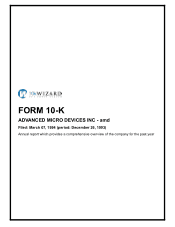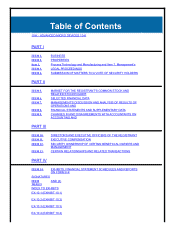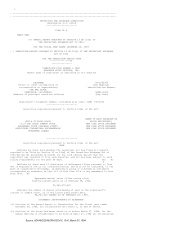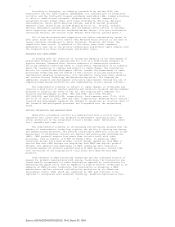AMD 1993 Annual Report Download - page 11
Download and view the complete annual report
Please find page 11 of the 1993 AMD annual report below. You can navigate through the pages in the report by either clicking on the pages listed below, or by using the keyword search tool below to find specific information within the annual report.-
 1
1 -
 2
2 -
 3
3 -
 4
4 -
 5
5 -
 6
6 -
 7
7 -
 8
8 -
 9
9 -
 10
10 -
 11
11 -
 12
12 -
 13
13 -
 14
14 -
 15
15 -
 16
16 -
 17
17 -
 18
18 -
 19
19 -
 20
20 -
 21
21 -
 22
22 -
 23
23 -
 24
24 -
 25
25 -
 26
26 -
 27
27 -
 28
28 -
 29
29 -
 30
30 -
 31
31 -
 32
32 -
 33
33 -
 34
34 -
 35
35 -
 36
36 -
 37
37 -
 38
38 -
 39
39 -
 40
40 -
 41
41 -
 42
42 -
 43
43 -
 44
44 -
 45
45 -
 46
46 -
 47
47 -
 48
48 -
 49
49 -
 50
50 -
 51
51 -
 52
52 -
 53
53 -
 54
54 -
 55
55 -
 56
56 -
 57
57 -
 58
58 -
 59
59 -
 60
60 -
 61
61 -
 62
62 -
 63
63 -
 64
64 -
 65
65 -
 66
66 -
 67
67 -
 68
68 -
 69
69 -
 70
70 -
 71
71 -
 72
72 -
 73
73 -
 74
74 -
 75
75 -
 76
76 -
 77
77 -
 78
78 -
 79
79 -
 80
80 -
 81
81 -
 82
82 -
 83
83 -
 84
84 -
 85
85 -
 86
86 -
 87
87 -
 88
88 -
 89
89 -
 90
90 -
 91
91 -
 92
92 -
 93
93 -
 94
94 -
 95
95 -
 96
96 -
 97
97 -
 98
98 -
 99
99 -
 100
100 -
 101
101 -
 102
102 -
 103
103 -
 104
104 -
 105
105 -
 106
106 -
 107
107 -
 108
108 -
 109
109 -
 110
110 -
 111
111 -
 112
112 -
 113
113 -
 114
114 -
 115
115 -
 116
116 -
 117
117 -
 118
118 -
 119
119 -
 120
120 -
 121
121 -
 122
122 -
 123
123 -
 124
124 -
 125
125 -
 126
126 -
 127
127 -
 128
128 -
 129
129 -
 130
130 -
 131
131 -
 132
132 -
 133
133 -
 134
134 -
 135
135 -
 136
136 -
 137
137 -
 138
138 -
 139
139 -
 140
140 -
 141
141 -
 142
142 -
 143
143 -
 144
144 -
 145
145 -
 146
146 -
 147
147 -
 148
148 -
 149
149 -
 150
150 -
 151
151 -
 152
152 -
 153
153 -
 154
154 -
 155
155 -
 156
156 -
 157
157 -
 158
158 -
 159
159 -
 160
160 -
 161
161 -
 162
162 -
 163
163 -
 164
164 -
 165
165 -
 166
166 -
 167
167 -
 168
168 -
 169
169 -
 170
170 -
 171
171 -
 172
172 -
 173
173 -
 174
174 -
 175
175 -
 176
176 -
 177
177 -
 178
178 -
 179
179 -
 180
180 -
 181
181 -
 182
182 -
 183
183 -
 184
184 -
 185
185 -
 186
186 -
 187
187 -
 188
188 -
 189
189 -
 190
190 -
 191
191 -
 192
192 -
 193
193 -
 194
194 -
 195
195 -
 196
196 -
 197
197 -
 198
198 -
 199
199 -
 200
200 -
 201
201 -
 202
202 -
 203
203 -
 204
204 -
 205
205 -
 206
206 -
 207
207 -
 208
208 -
 209
209 -
 210
210 -
 211
211 -
 212
212 -
 213
213 -
 214
214 -
 215
215 -
 216
216 -
 217
217 -
 218
218 -
 219
219 -
 220
220 -
 221
221 -
 222
222 -
 223
223 -
 224
224 -
 225
225 -
 226
226 -
 227
227 -
 228
228 -
 229
229 -
 230
230 -
 231
231 -
 232
232 -
 233
233 -
 234
234 -
 235
235 -
 236
236 -
 237
237 -
 238
238 -
 239
239 -
 240
240 -
 241
241 -
 242
242 -
 243
243 -
 244
244 -
 245
245 -
 246
246 -
 247
247 -
 248
248 -
 249
249 -
 250
250 -
 251
251 -
 252
252 -
 253
253 -
 254
254 -
 255
255 -
 256
256 -
 257
257 -
 258
258 -
 259
259 -
 260
260 -
 261
261 -
 262
262 -
 263
263 -
 264
264 -
 265
265 -
 266
266 -
 267
267 -
 268
268 -
 269
269 -
 270
270 -
 271
271 -
 272
272 -
 273
273 -
 274
274 -
 275
275 -
 276
276 -
 277
277 -
 278
278 -
 279
279 -
 280
280 -
 281
281 -
 282
282 -
 283
283 -
 284
284 -
 285
285 -
 286
286 -
 287
287 -
 288
288 -
 289
289 -
 290
290 -
 291
291 -
 292
292 -
 293
293 -
 294
294 -
 295
295 -
 296
296 -
 297
297 -
 298
298 -
 299
299 -
 300
300 -
 301
301 -
 302
302 -
 303
303 -
 304
304 -
 305
305 -
 306
306 -
 307
307 -
 308
308 -
 309
309 -
 310
310 -
 311
311 -
 312
312 -
 313
313 -
 314
314 -
 315
315 -
 316
316 -
 317
317 -
 318
318 -
 319
319 -
 320
320 -
 321
321 -
 322
322 -
 323
323 -
 324
324 -
 325
325 -
 326
326 -
 327
327 -
 328
328 -
 329
329 -
 330
330 -
 331
331 -
 332
332 -
 333
333 -
 334
334 -
 335
335 -
 336
336 -
 337
337 -
 338
338 -
 339
339 -
 340
340 -
 341
341 -
 342
342 -
 343
343 -
 344
344 -
 345
345 -
 346
346 -
 347
347 -
 348
348 -
 349
349 -
 350
350 -
 351
351 -
 352
352 -
 353
353 -
 354
354 -
 355
355 -
 356
356 -
 357
357 -
 358
358 -
 359
359 -
 360
360 -
 361
361 -
 362
362 -
 363
363 -
 364
364 -
 365
365 -
 366
366 -
 367
367 -
 368
368 -
 369
369 -
 370
370 -
 371
371 -
 372
372 -
 373
373 -
 374
374 -
 375
375 -
 376
376 -
 377
377 -
 378
378 -
 379
379 -
 380
380 -
 381
381 -
 382
382 -
 383
383 -
 384
384 -
 385
385 -
 386
386 -
 387
387 -
 388
388 -
 389
389 -
 390
390 -
 391
391 -
 392
392 -
 393
393 -
 394
394
 |
 |
7
According to Dataquest, an industry research firm, during 1993, the
Corporation was the fifth-largest independent U.S. manufacturer of integrated
circuits, and the thirteenth largest worldwide (excluding IBM), ranked according
to sales to unaffiliated customers. Advanced Micro Devices competes for
integrated circuit market share with Texas Instruments, Motorola, National
Semiconductor, Intel, North American Philips, and with several prominent
Japanese firms. These firms include Nippon Electric Co., Hitachi, Toshiba,
Fujitsu, Matsushita and Mitsubishi, who are making active efforts to increase
their respective and collective worldwide market shares. (For more information
concerning Fujitsu, see section Joint Venture with Fujitsu Limited above.)
All of the above-mentioned competitors are either substantially larger in
both gross sales and in total assets than Advanced Micro Devices or are part of
larger corporate enterprises to whose resources, financial and other, the
competitors have access. In addition to the above, many other companies
dedicated to only one or two process technologies and product types compete with
the Corporation in those technologies and product types.
RESEARCH AND DEVELOPMENT
In keeping with its objective of increasing emphasis on the development of
proprietary products while maintaining its role as a high-volume producer of
popular designs, Advanced Micro Devices endeavors to manufacture products
utilizing advanced technology which is consistently reproducible in an industry
where the technology is complex and subject to rapid change. The Corporation
directs its research and development efforts towards the advancement of wafer
processing technology and the design of new circuits utilizing consistently
reproducible advanced technologies. (For information concerning these advances
see section Process Technology and Manufacturing below.) The Corporation
emphasizes research and development efficiency improvements through the use of
computer-aided design workstations and complementary circuit design software.
The semiconductor industry is subject to rapid changes in technology and
requires a high level of capital spending and extensive research and development
programs to maintain the state of the art. The Corporation's expenses for
research and development in 1991, 1992 and 1993, were $213,765,000,
$227,860,000, and $262,802,000, respectively. Such expenses were 17.4%, 15.0%
and 16.0% of sales in 1991, 1992 and 1993, respectively. Advanced Micro Devices'
research and development expenses are charged to operations as incurred. Most of
the research and development personnel are integrated into the engineering
staff.
PROCESS TECHNOLOGY AND MANUFACTURING
Monolithic integrated circuits are manufactured from a circuit layout
separated into layers that are produced on photomasks (working plates). The
actual production of the integrated circuit includes wafer fabrication, wafer
sort, assembly and final test.
The semiconductor industry is increasingly process-based, meaning that the
advance of semiconductor technology requires the ability to develop new design
and manufacturing processes. The process technologies generally utilized in the
manufacture of integrated circuits are bipolar and metal-oxide semiconductor
(MOS). CMOS products require less power than circuits built with other
processes, such as bipolar or N-MOS (N-channel MOS). In addition, CMOS
technology allows for a much broader circuit design capability than NMOS or
bipolar and thus CMOS designs are displacing both NMOS and bipolar product
designs. The advances and advantages of CMOS technology have created an
increased demand for products manufactured with CMOS processes. During 1993,
over two-thirds of the Corporation's total sales were derived from CMOS
products.
With advances in CMOS processing technology and the continued erosion of
demand for products manufactured with bipolar technology, the Corporation has
significantly streamlined its wafer fabrication capacity by restructuring its
manufacturing capabilities from an emphasis on bipolar process technology to an
emphasis on CMOS process technology. The Corporation is primarily a CMOS
manufacturer and has achieved cost-effective production in its Submicron
Development Center (SDC) which was completed in 1991 and continues to be
improved to incorporate more advanced technology. Am386 microprocessors have
6
Source: ADVANCED MICRO DEVIC, 10-K, March 07, 1994
